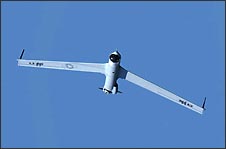 By Susan Garrett Crowley
By Susan Garrett Crowley
Insitu, a local drone developer now owned by Boeing, has recently approached cities in the Columbia River Gorge as a part of a public relations campaign to develop public support for its operations. Since Boeing/Insitu has initiated this discussion, Washington and Oregon citizens may want to carefully consider the true nature of what it is designed to do for the U.S. military. Insitu clients include the U.S. Navy, Marines, Air Force, and others it is not at liberty to divulge. (The Oregonian, July 23, 2008, “Boeing swoops into gorge,†by Allan Brettman.)
Would You Invite a
Killer into Your Neighborhood?
Insitu drones were developed to track moving targets on the ground. Early Insitu scientists had hoped to develop a product that would track fish schools for the kill, but found a limited market. Instead, its drones will probably be used directly or indirectly to track humans for the kill, as well as for simple surveillance.
Boeing/Insitu now choose to emphasize reconnaissance, not targeting assistance, but their development history shows that both are intended. A development report dated April 14, 2005 and then posted on Insitu’s website described testing of its drone ScanEagle at White Sands Missile Range: The drone ” . . . provided . . . targeting support and [was] used to derive targeting information for the delivery of an ATAC missile and JDAM missile.”
According to the website, in March and June of 2004, the ScanEagle flew with a larger Predator drone — which is not made by Insitu, but which is armed and used in assassination missions — during tests of “hand-off strategies” with the Predator as they “prosecute targets” Preliminary results indicated “that ScanEagle was among the quickest for target acquisition and most accurate for target location designation.”
Insitu drones have now been used by the U.S. Marines, Navy and Air Force and in both Iraq and Afghanistan. (Seattle Post-Intelligencer, May 22, 2009, “Boeing subsidiary gets big contract,” by Shannon Dininny, AP.) The Boeing/Insitu website is no longer so frank.
 From miles on high there is no way for a drone to project exactly who the human beings inside targeted buildings or vehicles might be. Many are individuals who die tragically in crossfire not of their making. Inevitable targeting mistakes have already created more enemies for the U.S. in Iraq, Pakistan and Afghanistan, whose citizens refuse to consider their lost family members merely “collateral damage.”Φ
From miles on high there is no way for a drone to project exactly who the human beings inside targeted buildings or vehicles might be. Many are individuals who die tragically in crossfire not of their making. Inevitable targeting mistakes have already created more enemies for the U.S. in Iraq, Pakistan and Afghanistan, whose citizens refuse to consider their lost family members merely “collateral damage.”Φ
No-Risk Murder
Drones facilitate arm’s-length killing (The Oregonian, January 2, 2008, “U.S. military using more drone crafts” by Lolita C. Baldor, AP. Remote control locations include places like Texas and North Dakota.)with no risk to the killer. Warfare without apparent cost can result in warfare without thought. It makes it easy for us to think we can occupy a foreign country and then savage our opposition and assassinate inconvenient local leaders — all by manipulating a computer joystick many miles away.
Moreover, it’s now assumed that the U.S. government can execute targeted assassinations of foreign citizens without benefit of any judicial process, an idea that would have been unthinkable just a decade ago and violates norms of international law. An official acknowledged this week that 367 people are now on the U.S. military’s kill list (New York Times, 8/10/09).
This is all done in our name, and Boeing/Insitu has an important role in it. Do we want to accept this with our silence? We already pay for it with our tax dollars.
 We might take the lead of Insitu founder Tad McGeer, who left the company in part out of discomfort with its growing military focus. If Boeing/Insitu is asking for an endorsement of that kind of development in our communities, before we take their 30 pieces of silver, we might at least have an informed discussion of the role they play in forming the world our children will inherit.
We might take the lead of Insitu founder Tad McGeer, who left the company in part out of discomfort with its growing military focus. If Boeing/Insitu is asking for an endorsement of that kind of development in our communities, before we take their 30 pieces of silver, we might at least have an informed discussion of the role they play in forming the world our children will inherit.
Susan Garrett Crowley is a retired Hood River attorney and former mediator. A version of this article was published in the Hood River News on August 12, 2009. It is reprinted with permission.
Photo courtesy of Crowley: www.Facebook.com; ScanEagle photo courtesy of: http://blog.seattlepi.com/venture/archives/144061.asp
